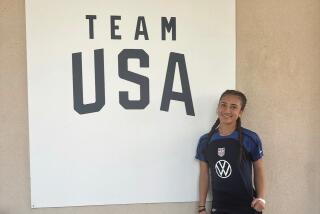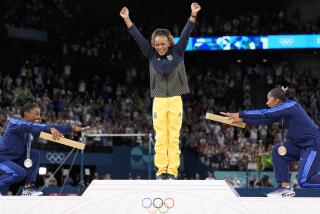ANALYSIS : High School Competition Risky for Sprinter in Olympic Year
- Share via
Marion Jones is caught in a tug of war between high school sports and the United States Olympic movement.
The national-class sprinter wants to be a regular high school student, competing on the track team at Thousand Oaks High as well as on the basketball team. Yet the U.S. Olympic Trials in track and field are but five months away and Jones’ chances of making the Olympic team could be impaired by her participation in high school track meets, not to mention basketball games.
It is reasonably safe to say that no other potential member of the 1992 U.S. Olympic track and field team is playing high school basketball this season.
Jones’ philosophy is such that during basketball season basketball is her favorite sport, and during track season track is her favorite sport.
At a press conference last month to promote the Sunkist Invitational indoor track and field meet, Jones said she loved basketball, she understood the risks of playing it and that if she didn’t play she would be unhappy.
Not only was basketball a risk because of the potential for injury--a potential unfortunately realized when Jones suffered a fractured left wrist and dislocated jaw Jan. 9 in a game against Simi Valley--her participation in that sport prevented her from devoting more time to her ongoing track workouts and being physically fresher for them.
Now, with the wrist in a cast, those workouts will have to be modified.
The injury risk was just one gamble the 16-year-old Jones took when she defied traditional Olympic-preparation philosophies. She also changed coaches approximately 10 months before the trials, from Brian FitzGerald of Rio Mesa High to Elliott Mason Jr., who has been working with her one on one since August.
The danger is that a new coach might not succeed as well with the taper (the period in which an athlete rests and decreases his/her training regimen before major competition).
Tapering is tricky. Too little or too much rest yields the same result--a (relatively-speaking) slow performance.
The other factor is experience. Over time, a coach knows an athlete’s moods and how to react to them as well as what makes an athlete work harder, when to back off and which pre-race atmosphere produces great performances.
FitzGerald coached Jones for two seasons at Rio Mesa before her transfer at the end of November to Thousand Oaks. Under his tutelage Jones came within five-hundredths of a second of making the 1991 World Championship team in the 200 meters, setting a national junior (19 and under) and high school record with her time of 22.76 seconds.
Moreover, that time put Jones within one place of where she needs to be at the trials: The top three finishers advance to the Olympic Games in Barcelona. Jones also could make the U. S. team as a member of the 4 x 100 relay team with a top-six finish in the 100 meters.
Even though Mason could quickly develop a feel for her moods, training habits and meet-day tendencies, Jones still is taking a chance. Under Mason she might not replicate her past efforts.
Then again, she could make even greater strides. One advantage of youth is a substantial learning curve.
Certainly, Mason has credentials. He served as training partner for three-time Olympic gold medalist Evelyn Ashford for five years and, as a sports psychologist, he is well-qualified to deal with the motivational aspects of coaching.
Also, Mason is keeping the workouts lively by literally training with Jones.
Like FitzGerald, Mason favors allowing her to be a high school athlete while exploring her world-class potential in track.
“It’s not the end-all to make the Olympic team,” Mason said. “It is within her grasp. I told her the risks and that it (basketball) might take away from her training. I didn’t tell her it had to be all or nothing.
“There are rest cycles to any (training) foundation. Basketball can fit in. . . . It’s like cross-training.
“My goal is to have her healthy, even if she’s less prepared (for the trials). Her emotional health is also important and at this point the key to that is (being allowed to play) basketball.”
Tom Tellez, personal coach for Carl Lewis, the world record-holder in the 100 meters, stressed the importance of a well-rounded high school experience but added: “If it was my daughter and knowing what it takes to get (to the Olympics), I would suggest not playing basketball. When you have a chance to make the Olympic team you have to put everything into it. She could play basketball next year.”
Not only does Tellez believe Jones can make the Olympic team, wrist injury notwithstanding, he thinks she could place.
“There’s no doubt in my mind that she could be a medalist,” Tellez said. “But it’s difficult if she is playing basketball and doing other things. The level of concentration might not be as good as it could be if she were in college.”
In a non-Olympic year, Thousand Oaks basketball Coach Chuck Brown, a proponent of multisport athletes, would expect Jones to add her 17.2 scoring average to the local high school basketball team.
“She’s 16 and she wants to have fun,” Brown said. “There have been a lot of people who’ve said she should be specializing, but she’s so young. You take the ice skaters who put in so many hours and can’t seem to do anything in life. I think Marion wants to do other things.”
Brown, who is also the Lancer softball coach, is frustrated by the specialization trend at the high school level in all sports.
In recent years he stopped allowing players’ club volleyball schedules to conflict with high school practices or games.
Brown, however, was flexible with Jones’ track practice schedule because of her Olympic aspirations.
“There’s a big bunch of difference between a club sport and an Olympic athlete,” he said.
Despite Brown’s feelings about specialization, he would have understood if Jones had passed up basketball during an Olympic year. That’s why he was thrilled when she came out for the team in November.
“I thought it was really neat,” he said. “That she cares enough about it. It’s extremely unfortunate that she got hurt.”
Competing in high school track during an Olympic year puts Jones at further risk. Mason is familiar with the conflict, but he usually sees it at the collegiate level.
“Our college system is not geared for it (international success) so few of our college athletes make the (Olympic) team,” he said.
“Individual goals clash with team goals and (athletes) are not rested enough for the trials.”
With its many meets, the high school track schedule cuts into training.
“If she needed not to run a certain meet she wouldn’t necessarily run,” Mason said. “But you’ve got to understand you’re dealing with a 16-year-old. You don’t force a youngster to do anything. They rebel.”
Mason does not want to make too much of the 1992 Olympics when there are more Olympiads ahead. Jones, despite her tender years and her sprinting ways, is also looking at the long run.
More to Read
Get our high school sports newsletter
Prep Rally is devoted to the SoCal high school sports experience, bringing you scores, stories and a behind-the-scenes look at what makes prep sports so popular.
You may occasionally receive promotional content from the Los Angeles Times.





